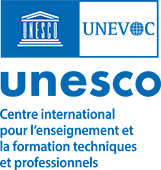
Le Centre International UNESCO-UNEVOC: Qui nous sommes | Ce que nous faisons | Nous rejoindre | Nous contacter
Le Réseau UNEVOC: En savoir plus sur le Réseau | Répertoire du Réseau UNEVOC
Espace Membres: Tableau de bord du Centre UNEVOC
Domaines thématiques: Inclusion et jeunes | Innovation et avenir de l'EFTP | Engagement du secteur privé | Les ODD et l'écologisation de l'EFTP
Nos programmes et projets clés: BILT: Connecter innovation et apprentissage | Renforcer la résilience de l’EFTP | Programme pour le leadership en EFTP | Journée mondiale des compétences des jeunes
Activités passées: Réponse COVID-19 | i-hubs: Former des pôles d'innovation | Forums mondiaux de l'EFTP | Conférences virtuelles | YEM Portail de connaissances
Nos services et ressources: Publications | Forum TVET | Profils nationaux d'EFTP | Glossaire TVETipedia | Pratiques prometteuses | Toolkits for TVET Providers | Formation à l’entrepreneuriat
Journal et événements: Grandes Manifestations EFTP | Journal UNEVOC
Significant progress has been made in advancing gender equality and girls’ and women’s education.
UNESCO data shows that girls’ enrolment has improved dramatically over the past 25 years; 180 million more girls are enrolled in primary and secondary education. Between 1995 and 2019, the primary school enrolment rate of girls increased from 79 to 90 percent, while the percentage of boys enrolled increased from 86 to 92. Completion rates also improved, with girls’ primary school completion rate increasing by almost 20 percentage points to 87 percent during the period. The fastest progress was in Central and Southern Asia, where in 1995 just over half of girls completed primary school, but a generation later almost 90 percent of their daughters do so. And the pursuit of education continues; globally, 118 million women and 110 million men were participating in tertiary education in 2019.
But many challenges remain: In 2020, 260 million children and youth were out of school – just over half of whom were boys. Women still accounted for almost two-thirds of adults unable to read in 2019. Digital literacy gaps are widening. Among 10 low- and middle-income countries with data, women are less likely than men to have used a basic arithmetic formula in a spreadsheet in the 7 poorest countries, while parity exists in the 3 richest countries.